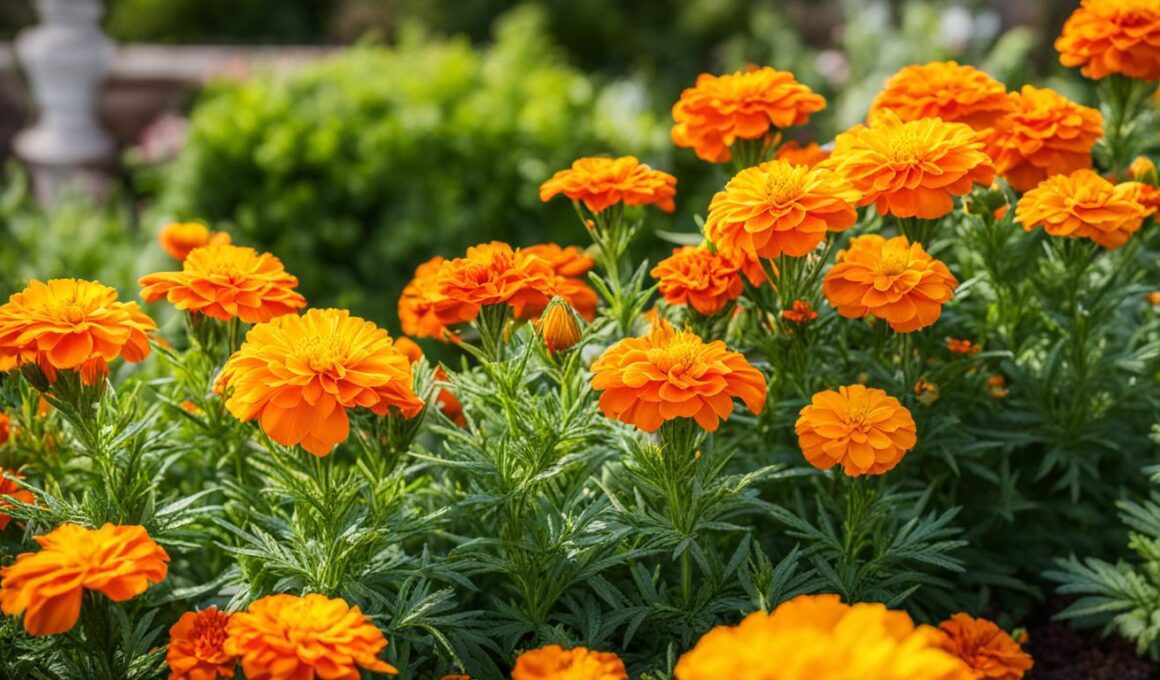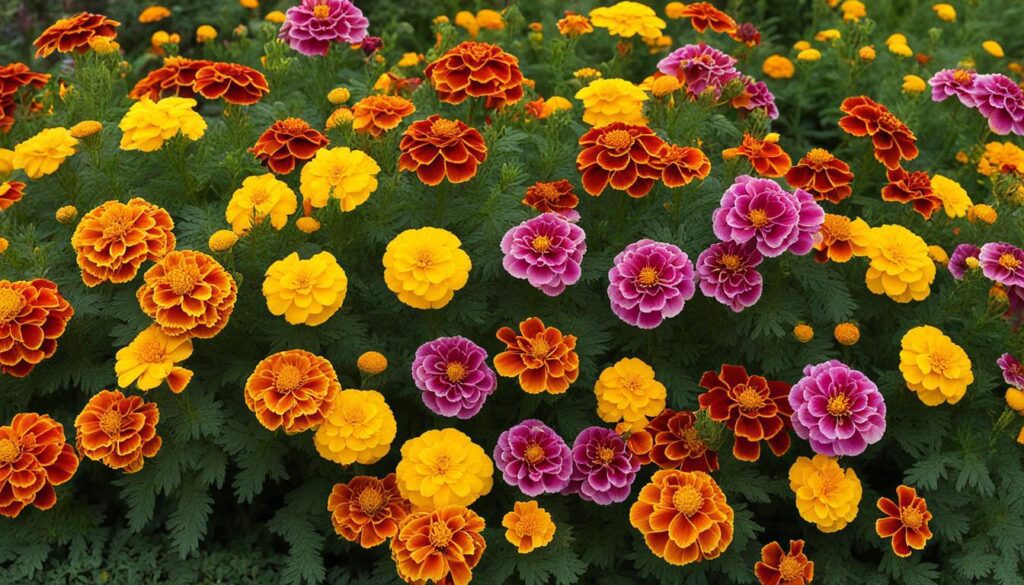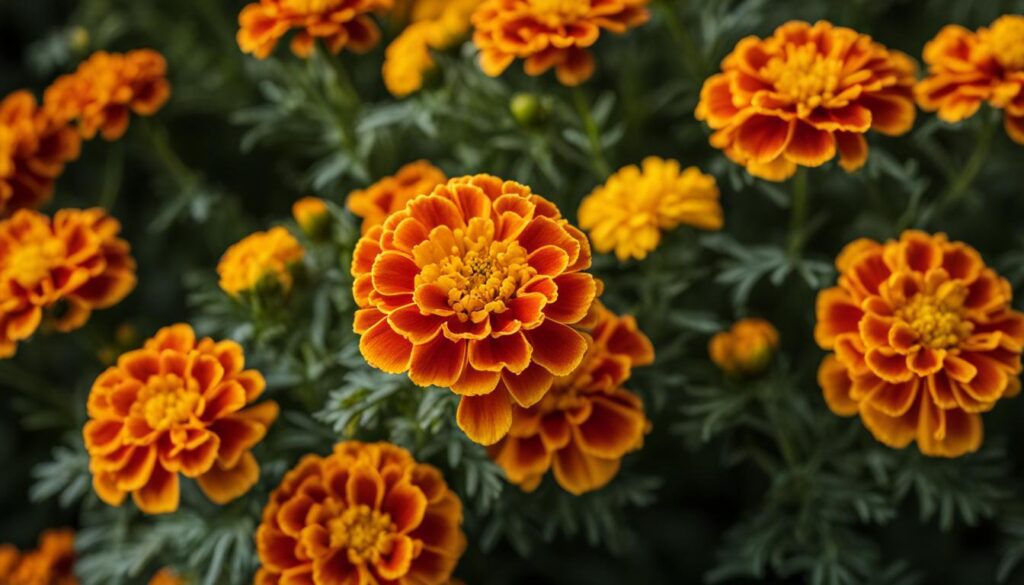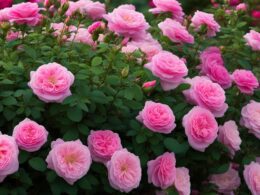Marigolds are beloved flowers known for their vibrant colors and ability to add beauty to gardens. But are they perennial or annual plants? Let’s explore the growth cycle of marigolds and find out.
Most marigolds are treated as annuals, meaning they complete their life cycle within a single year. However, there are certain species of marigolds that have the potential to behave as perennials under the right conditions.
Marigolds have a unique characteristic – they self-seed. This means that even though they technically are annuals, they can regrow from the seeds they drop, giving the impression of a perennial plant. The various types of marigolds include African marigolds, French marigolds, Mexican marigolds, signet marigolds, and desert marigolds.
Marigolds are vascular herbaceous plants with oblong leaves and vibrant petals. They come in a wide range of colors, including yellows, oranges, and reds. These versatile flowers can thrive in USDA hardiness zones 2-11, although extremely cold or hot regions may not be suitable for their growth.
Key Takeaways:
- Marigolds can be both annual and perennial, depending on the specific species and growing conditions.
- Most marigolds are treated as annuals and complete their life cycle within a year.
- Marigolds can appear to be perennials due to their self-seeding ability.
- The different types of marigolds include African, French, Mexican, signet, and desert marigolds.
- Marigolds are vascular herbaceous plants with oblong leaves and vibrant petals, growing in USDA hardiness zones 2-11.
Different Types of Marigolds and Their Characteristics
Marigolds come in a variety of species, each with its own unique characteristics. Understanding the different types of marigolds can help you choose the perfect variety for your garden. Here are some popular types:
African Marigolds
African marigolds are known for their tall stature and vibrant colors. They are more tolerant of hot and dry conditions compared to other varieties. African marigolds can reach heights of up to 3 feet and produce large, showy flowers. Their blooms come in shades of yellow, orange, and rust.
French Marigolds
French marigolds offer a wide range of colorful options, including vibrant yellows, oranges, and reds. They are typically smaller in size compared to African marigolds, making them perfect for borders or container gardens. French marigolds have a compact growth habit and produce abundant flowers throughout the summer.
Mexican Marigolds
Mexican marigolds, also known as Tagetes lemmonii, are perennial marigolds with a strong root system. They are often grown as shrubs and can reach heights of up to 4 feet. Mexican marigolds produce bright orange or yellow flowers and are known for their strong fragrance.
Signet Marigolds
Signet marigolds, also called Tagetes tenuifolia, are heat-loving and drought-resistant plants. They have delicate, fern-like foliage and small, dainty flowers compared to other marigold varieties. Signet marigolds come in shades of yellow and orange and add a unique touch to any garden.
Desert Marigolds
Desert marigolds, or Baileya multiradiata, are native wildflowers that are well-suited to arid regions. They have bright yellow flowers and silvery-gray foliage. Desert marigolds are not picky about soil type but require good drainage to thrive.
Marigolds come in different species and variations, each with its own unique characteristics. African marigolds are taller and more tolerant of hot, dry conditions, while French marigolds offer vibrant yellows, oranges, and reds. Mexican marigolds are perennials with a strong root system and are often grown as shrubs. Signet marigolds are heat-loving and drought-resistant plants with different-looking petals compared to other variations. Desert marigolds are native wildflowers that are not picky about soil type but require good drainage. Each type of marigold adds beauty and color to gardens and can grow almost anywhere.
Whether you choose African, French, Mexican, signet, or desert marigolds, these flowers are sure to add beauty and vibrancy to your garden. Experiment with different varieties to create stunning displays and enjoy the unique characteristics of each type of marigold.
Growing Conditions and Hardy Zones for Marigolds
Marigolds are incredibly adaptable flowers that can thrive in a variety of growing conditions, making them suitable for gardeners of all skill levels. These vibrant blooms prefer full sun exposure and moderate fertility in the soil. Planting marigolds in well-drained soil is ideal, as they can withstand dry conditions and do not require excessive watering.
When it comes to hardiness zones, marigolds are versatile plants that can grow in USDA hardiness zones 2-11. However, it’s important to note that extremely cold or hot regions (zones 1, 12, and 13) may not be suitable for marigold cultivation. In all other zones, marigolds can adapt and flourish, adding beauty and color to your garden.
Key Growing Conditions for Marigolds:
- Full sun exposure
- Moderate fertility in the soil
- Well-drained soil
- Tolerant of drought conditions
USDA Hardiness Zones for Marigolds:
Marigolds can grow in USDA hardiness zones 2-11, except for zones 1, 12, and 13.
Marigolds are adaptable plants that can survive in various soil types and climates. Whether you have sandy soil or clay soil, marigolds can thrive as long as the soil has good drainage. Their ability to withstand different conditions makes marigolds an excellent choice for both novice and experienced gardeners.
Perennial Behavior of Marigolds
While most marigolds are considered annuals, African marigolds have the potential to behave as perennials in certain conditions. In mild climates with infrequent frost, African marigolds have a higher chance of returning in subsequent years. Factors such as winter protection, microclimates, and proper care practices can influence the perennial behavior of African marigolds. However, it’s important to note that their perennial nature is not guaranteed in all climates, and they are typically treated as annuals in regions with harsh winters.
Factors Affecting Perennial Behavior
African marigolds can display perennial behavior when provided with the right conditions. Winter protection is crucial to safeguarding these flowers from freezing temperatures. Techniques such as mulching with straw, using frost blankets, or moving potted plants indoors can help insulate them and prevent damage. Additionally, creating microclimates by planting marigolds in sheltered areas, such as against a sunny wall or near a heat-retaining structure, can contribute to their chances of overwintering successfully.
Proper care practices also play a role in promoting the perennial behavior of African marigolds. Regular deadheading—removing spent blooms—encourages continuous blooming and reduces the energy spent on seed production. Adequate watering, especially during drought conditions, and providing sufficient nutrients through balanced fertilization contribute to the plant’s overall health and resilience.
Regional Considerations
It’s essential to consider the specific climate of your region when determining the perennial behavior of African marigolds. In areas with extremely cold winters and frequent frosts, these flowers are best treated as annuals, and replanting each year is necessary to maintain their vibrant display. However, in milder climates or with proper winter protection, African marigolds may survive the winter and exhibit perennial characteristics, delighting gardeners with their return each year.
Planting and Care Tips for Marigolds
Marigolds are a popular choice for gardeners due to their vibrant colors and easy cultivation. Whether you prefer to grow them from seeds or ready-grown bedding plants, here are some planting and care tips to help you successfully grow marigolds in your garden:
- Choose the right time: Marigolds can be sown directly into the soil or started indoors. For summer flowers, sow calendula marigolds in March, April, or May. If you prefer flowers the following year, sow them in August or September. Tagetes marigolds should be sown outdoors after the danger of frost has passed in your region.
- Find the perfect spot: Marigolds thrive in full sun exposure, so choose a location in your garden that receives at least six hours of direct sunlight per day. They also prefer well-drained soil, so make sure the area has good drainage.
- Water regularly: While marigolds are relatively drought-tolerant, it’s important to water them regularly, especially during dry and hot weather. Check the soil moisture level, and water when the top inch of soil feels dry to the touch.
Marigolds require minimal maintenance, but deadheading (removing spent flowers) is not necessary. However, it can prolong their blooming period and keep the plant looking tidy. If you choose to deadhead, simply pinch off the faded flowers.
Aside from their beauty, marigolds offer several benefits in the garden. They attract pollinators like butterflies, bees, and hummingbirds, making them valuable for supporting a healthy ecosystem. Additionally, marigolds act as companion plants, helping to protect other plants from pests and deterring certain insects. Their vibrant colors also make them excellent cut flowers for floral arrangements.
By following these planting and care tips, you can enjoy the beauty and benefits of marigolds in your garden. Whether you’re a seasoned gardener or just starting out, marigolds are a great choice for adding color and vibrancy to your outdoor space.
Winter Protection for Marigolds
Marigolds are beautiful flowers that add vibrant colors to your garden during the warmer months. However, when winter arrives, it’s important to take steps to protect your marigolds from frost and cold temperatures. Proper winter care can help ensure the survival of these delicate plants and potentially allow them to exhibit perennial behavior in mild climates.
To protect marigolds from frost, you can use several strategies. One effective method is to apply a layer of mulch around the base of the plants. Mulch acts as insulation, helping to retain heat and protect the roots from freezing temperatures. Additionally, you can consider using heat lamps or covers to provide extra warmth during particularly cold nights.
Remember to cover the marigolds at night when temperatures are expected to drop below freezing. This extra layer of protection can make a significant difference in the plants’ survival.
While winter protection can increase the chances of marigolds surviving through the colder months, it’s important to note that in regions with freezing temperatures, marigolds are typically treated as annuals. Planting new marigolds each year is necessary to ensure continuous blooms and healthy plants. However, in milder climates or with proper winter care, certain species like African marigolds may exhibit perennial behavior, delighting you with their colorful blooms year after year.
Key Points:
- Protecting marigolds from frost is essential for their survival during the winter months.
- Mulching around the base of the plants provides insulation and helps retain heat.
- Using heat lamps or covers can offer additional warmth during cold nights.
- In regions with freezing temperatures, marigolds are typically treated as annuals and require replanting each year.
- In milder climates or with proper winter care, certain marigold species like African marigolds may exhibit perennial behavior.
Benefits and Uses of Marigolds in the Garden
Marigolds offer a multitude of benefits in the garden, making them a valuable addition to any landscape. One of the key advantages of marigolds is their ability to attract pollinators such as butterflies, bees, and hummingbirds. By planting marigolds, you can create a vibrant and thriving ecosystem, supporting the health and well-being of these important creatures.
Furthermore, marigolds are not only visually appealing but also versatile. They can be used as cut flowers in floral arrangements, adding a pop of color and a touch of elegance. Their vibrant petals make for stunning bouquets or decorative accents.
“Marigolds are excellent companion plants, offering natural pest control and protection for your vegetable garden.”
Another significant benefit of marigolds is their ability to act as companion plants. Marigolds release chemicals that deter certain pests, making them a natural and effective way to protect your vegetable garden. By interplanting marigolds with your vegetables, you can reduce the risk of pest infestations and promote the health and productivity of your crops.
The benefits of marigolds in the garden can be summarized as follows:
- Attract pollinators such as butterflies, bees, and hummingbirds
- Add vibrant colors and beauty to floral arrangements
- Act as companion plants for natural pest control in vegetable gardens
Conclusion
In conclusion, marigolds are fascinating flowers that can exhibit both annual and perennial behavior, depending on the specific variety and growing conditions. While most marigolds are treated as annuals, certain species like African marigolds have the potential to behave as perennials, especially in mild climates.
Understanding the different types of marigolds, their characteristics, and their growth cycle is essential for successful cultivation. Marigolds come in various species such as African marigolds, French marigolds, Mexican marigolds, signet marigolds, and desert marigolds, each offering its own unique traits and beauty.
Marigolds can thrive in a wide range of growing conditions and are generally low-maintenance flowers. They prefer full sun exposure, moderate fertility in the soil, and regular watering. Marigolds are suitable for USDA hardiness zones 2-11, making them adaptable to different climates.
Whether they bloom for a single season or return year after year, marigolds bring beauty, vibrant colors, and several benefits to any garden. They attract pollinators, can be used as cut flowers, act as companion plants, and deter pests. With their versatility and aesthetic appeal, marigolds are a popular choice for gardeners of all skill levels.
What is the Growth Cycle of Marigolds and Are They Perennial or Annual Plants?
Marigolds are perennial or annuals depending on the variety. The growth cycle starts with planting seeds in well-drained soil and full sun. They germinate in 4-7 days and bloom in about 8 weeks. Deadhead spent flowers to encourage continuous blooming. In colder climates, they are typically grown as annuals.
FAQ
Are marigolds annual or perennial flowers?
Marigolds can be both annual and perennial, but most are treated as annuals.
Do marigolds self-seed and replant themselves?
Yes, marigolds have the ability to self-seed and replant themselves, which can make them appear to be perennials.
What are the different types of marigolds?
The different types of marigolds include African marigolds, French marigolds, Mexican marigolds, signet marigolds, and desert marigolds.
What are the characteristics of African marigolds?
African marigolds are taller and more tolerant of hot, dry conditions.
What are the characteristics of French marigolds?
French marigolds offer vibrant yellows, oranges, and reds.
What are the characteristics of Mexican marigolds?
Mexican marigolds are perennials with a strong root system and are often grown as shrubs.
What are the characteristics of signet marigolds?
Signet marigolds are heat-loving and drought-resistant plants with unique-looking petals.
What are the characteristics of desert marigolds?
Desert marigolds are native wildflowers that are not picky about soil type but require good drainage.
What growing conditions do marigolds prefer?
Marigolds prefer full sun exposure, moderate soil fertility, and can tolerate drought conditions.
In which USDA hardiness zones can marigolds grow?
Marigolds can grow in USDA hardiness zones 2-11, except for extremely cold or hot regions.
Can African marigolds behave as perennials?
African marigolds have the potential to behave as perennials in mild climates with infrequent frost, but it is not guaranteed in all regions.
How can I protect marigolds from frost?
Measures such as using mulch, heat lamps, insulation, and covering the plants at night can help protect marigolds from frost.
What benefits do marigolds offer in the garden?
Marigolds attract pollinators, add color to the garden, protect other plants, and repel pests.












